check engine VOLVO XC90 TWIN ENGINE HYBRID 2017 Owner's Manual
[x] Cancel search | Manufacturer: VOLVO, Model Year: 2017, Model line: XC90 TWIN ENGINE HYBRID, Model: VOLVO XC90 TWIN ENGINE HYBRID 2017Pages: 584, PDF Size: 14.2 MB
Page 404 of 584
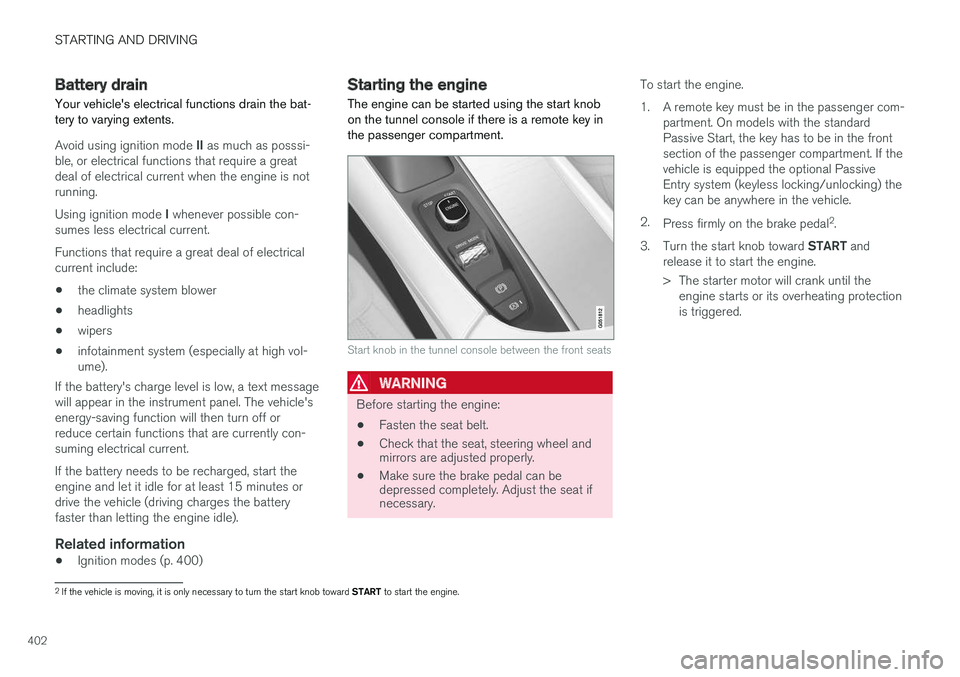
STARTING AND DRIVING
402
Battery drain
Your vehicle's electrical functions drain the bat-tery to varying extents.
Avoid using ignition mode II as much as posssi-ble, or electrical functions that require a greatdeal of electrical current when the engine is notrunning.
Using ignition mode I whenever possible con-sumes less electrical current.
Functions that require a great deal of electricalcurrent include:
•the climate system blower
•headlights
•wipers
•infotainment system (especially at high vol-ume).
If the battery's charge level is low, a text messagewill appear in the instrument panel. The vehicle'senergy-saving function will then turn off orreduce certain functions that are currently con-suming electrical current.
If the battery needs to be recharged, start theengine and let it idle for at least 15 minutes ordrive the vehicle (driving charges the batteryfaster than letting the engine idle).
Related information
•Ignition modes (p. 400)
Starting the engine
The engine can be started using the start knobon the tunnel console if there is a remote key inthe passenger compartment.
Start knob in the tunnel console between the front seats
WARNING
Before starting the engine:
•Fasten the seat belt.
•Check that the seat, steering wheel andmirrors are adjusted properly.
•Make sure the brake pedal can bedepressed completely. Adjust the seat ifnecessary.
To start the engine.
1.A remote key must be in the passenger com-partment. On models with the standardPassive Start, the key has to be in the frontsection of the passenger compartment. If thevehicle is equipped the optional PassiveEntry system (keyless locking/unlocking) thekey can be anywhere in the vehicle.
2.Press firmly on the brake pedal2.
3.Turn the start knob toward START andrelease it to start the engine.
> The starter motor will crank until theengine starts or its overheating protectionis triggered.
2If the vehicle is moving, it is only necessary to turn the start knob toward START to start the engine.
Page 405 of 584

STARTING AND DRIVING
}}
403
WARNING
•Never use more than one floor mat at atime on the driver's floor. Before driving,remove the original mat from the driver'sseat floor before using any other type offloor mat. Any mat used in this positionshould be securely and properly anchoredin the attaching pins. An extra mat on thedriver's floor can cause the acceleratorand/or brake pedal to catch. Check thatthe movement of these pedals is notimpeded.
•Volvo's floor mats are specially manufac-tured for your car. They must be firmlysecured in the clips on the floor so thatthey cannot slide and become trappedunder the pedals on the driver's side.
During normal starts, the electric motor is priori-tized and the gasoline engine will not start. Thismeans that when the start knob has been turnedtoward START and released, the electric motor isactivated ("started") and the vehicle is ready tobe driven. The warning and information symbolsin the instrument panel will go out and thechosen theme will be displayed to indicate thatthe electric motor has been activated.
However, in certain situations, such as in coldweather or if the hybrid battery is not sufficientlycharged, the gasoline engine will start instead.
NOTE
The vehicle cannot be started if the hybridbattery is discharged.
Back-up reader in the tunnel console
If Vehicle key not found is displayed in theinstrument panel, place the remote key in theback-up reader in the tunnel console (see theillustration) and try again to start the engine.
NOTE
When the remote key is in the back-upreader, be sure there are no other metallicobjects (e.g., other keys, coins, cell phones) inthe cup holder. This could affect the back-upreader's function.
If Vehicle start System check, wait is dis-played in the instrument panel when you try to
start the vehicle, wait until the message is nolonger displayed and try to start again.
CAUTION
If the engine does not start after the third try,wait for approximately 3 minutes before tryingto start it again to give the battery time torecover its starting capacity.
WARNING
•Always remove the remote key from thepassenger compartment when leaving thevehicle and ensure that the ignition inmode 0.
•On vehicles with the optional PassiveEntry, never remove the remote key fromthe vehicle while it is being driven ortowed.
•Always place the gear selector in Parkand apply the parking brake before leav-ing the vehicle. Never leave the vehicleunattended with the engine running.
•Always open garage doors fully beforestarting the engine inside a garage toensure adequate ventilation. The exhaustgases contain carbon monoxide, which isinvisible and odorless but very poisonous.
Page 410 of 584

STARTING AND DRIVING
408
Hybrid-related symbols andmessages
A number of symbols and messages relating tothe XC90 T8 Twin Engine Plug-in Hybrid may
appear in the instrument panel. They may alsobe displayed in combination with general indica-tor and warning symbols and will go out whenthe necessary action has been taken.
SymbolMessageExplanation
12 V Battery
Charging fault, service urgent. Driveto workshop
Battery fault. Contact a Volvo retailer or a trained and qualified Volvo service technician as soon aspossible.
12 V Battery
Charging fault Stop safely
Battery fault. Stop the vehicle as soon as possible and contact a Volvo retailer or a trained andqualified Volvo service technician.
12 V Battery
Low charge, temporarily reducedfunctionality
The hybrid battery's charge level is too low for optimal driving. Charge the battery as soon as possi-ble.
12 V Battery
Charging fault, low battery. Stopsafely
The hybrid battery is not sufficiently charged. Stop the vehicle as soon as possible and charge thebattery.
12 V Battery
Fuse failure Service required
Battery failure. Contact a Volvo retailer or a trained and qualified Volvo service technician as soon aspossible to have the system checked.
Hybrid battery
Overheated, stop safely
Battery temperature too high/too low. Stop the vehicle and turn off the engine. If the messageremains after the engine has been restarted, contact a Volvo retailer or a trained and qualified Volvoservice technician.
Page 411 of 584

STARTING AND DRIVING
409
SymbolMessageExplanation
Reduced performance
Max vehicle speed limited
The hybrid battery is not sufficiently charged for higher speeds. Charge the battery as soon as pos-sible.
Hybrid system
Harsh behavior at low speed, vehicleok to use
The hybrid system is not functioning completely properly. Contact a Volvo retailer or a trained andqualified Volvo service technician as soon as possible to have the system checked.
Hybrid system failure
Service required
The hybrid system is out of order. Contact a Volvo retailer or a trained and qualified Volvo servicetechnician as soon as possible to have the system checked.
Charge cable
Remove before start
The charging cable has not been disconnected and the driver has attempted to start the engine.Disconnect the cable from the vehicle, put the cover back in place and close the charger door.
Charge cable
Removed? Turn and hold start knob7s
The driver has already attempted to start the engine with the charging cable still connected. Besure the cable is completely disconnected, the cover is in place and the charger door is closed.
Related information
•Charging the hybrid battery (p. 413)
•Charger status indicators (p. 417)
•Hybrid battery charge status (p. 415)
Page 416 of 584
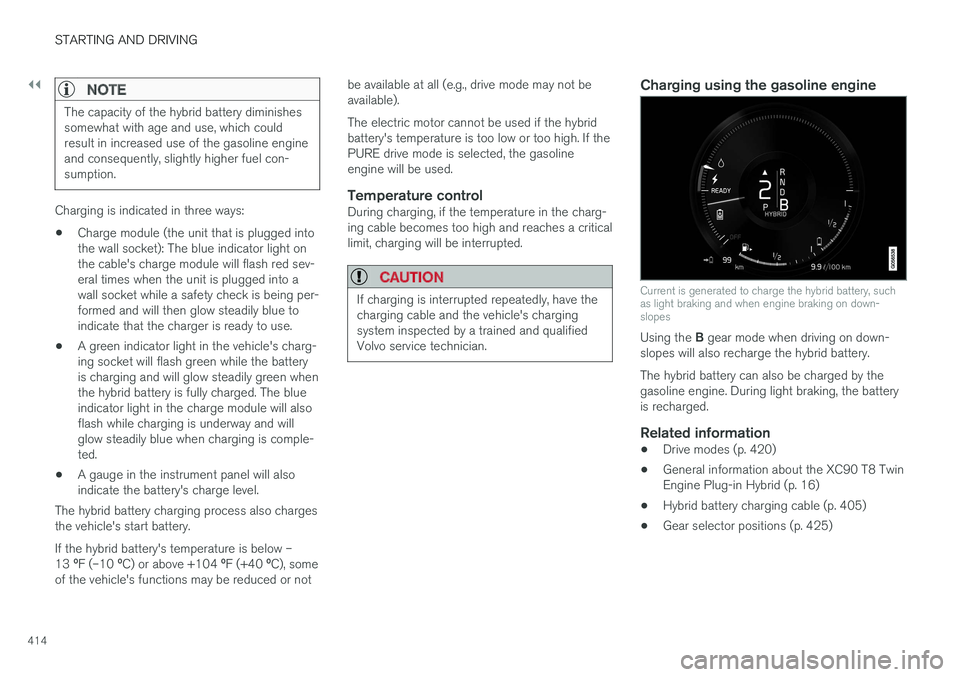
||
STARTING AND DRIVING
414
NOTE
The capacity of the hybrid battery diminishessomewhat with age and use, which couldresult in increased use of the gasoline engineand consequently, slightly higher fuel con-sumption.
Charging is indicated in three ways:
•Charge module (the unit that is plugged intothe wall socket): The blue indicator light onthe cable's charge module will flash red sev-eral times when the unit is plugged into awall socket while a safety check is being per-formed and will then glow steadily blue toindicate that the charger is ready to use.
•A green indicator light in the vehicle's charg-ing socket will flash green while the batteryis charging and will glow steadily green whenthe hybrid battery is fully charged. The blueindicator light in the charge module will alsoflash while charging is underway and willglow steadily blue when charging is comple-ted.
•A gauge in the instrument panel will alsoindicate the battery's charge level.
The hybrid battery charging process also chargesthe vehicle's start battery.
If the hybrid battery's temperature is below –13 ºF (–10 ºC) or above +104 ºF (+40 ºC), someof the vehicle's functions may be reduced or not
be available at all (e.g., drive mode may not beavailable).
The electric motor cannot be used if the hybridbattery's temperature is too low or too high. If thePURE drive mode is selected, the gasolineengine will be used.
Temperature control
During charging, if the temperature in the charg-ing cable becomes too high and reaches a criticallimit, charging will be interrupted.
CAUTION
If charging is interrupted repeatedly, have thecharging cable and the vehicle's chargingsystem inspected by a trained and qualifiedVolvo service technician.
Charging using the gasoline engine
Current is generated to charge the hybrid battery, suchas light braking and when engine braking on down-slopes
Using the B gear mode when driving on down-slopes will also recharge the hybrid battery.
The hybrid battery can also be charged by thegasoline engine. During light braking, the batteryis recharged.
Related information
•Drive modes (p. 420)
•General information about the XC90 T8 TwinEngine Plug-in Hybrid (p. 16)
•Hybrid battery charging cable (p. 405)
•Gear selector positions (p. 425)
Page 497 of 584
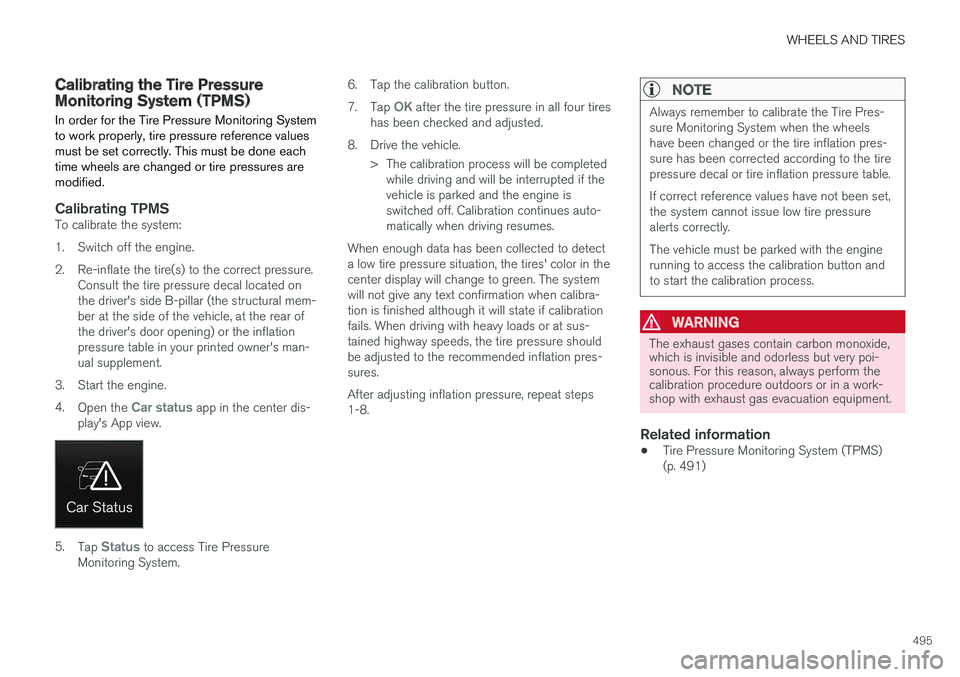
WHEELS AND TIRES
495
Calibrating the Tire PressureMonitoring System (TPMS)
In order for the Tire Pressure Monitoring Systemto work properly, tire pressure reference valuesmust be set correctly. This must be done eachtime wheels are changed or tire pressures aremodified.
Calibrating TPMS
To calibrate the system:
1. Switch off the engine.
2. Re-inflate the tire(s) to the correct pressure.Consult the tire pressure decal located onthe driver's side B-pillar (the structural mem-ber at the side of the vehicle, at the rear ofthe driver's door opening) or the inflationpressure table in your printed owner's man-ual supplement.
3. Start the engine.
4.Open the Car status app in the center dis-play's App view.
5.Tap Status to access Tire PressureMonitoring System.
6.Tap the calibration button.
7.Tap OK after the tire pressure in all four tireshas been checked and adjusted.
8.Drive the vehicle.
> The calibration process will be completedwhile driving and will be interrupted if thevehicle is parked and the engine isswitched off. Calibration continues auto-matically when driving resumes.
When enough data has been collected to detecta low tire pressure situation, the tires' color in thecenter display will change to green. The systemwill not give any text confirmation when calibra-tion is finished although it will state if calibrationfails. When driving with heavy loads or at sus-tained highway speeds, the tire pressure shouldbe adjusted to the recommended inflation pres-sures.
After adjusting inflation pressure, repeat steps1-8.
NOTE
Always remember to calibrate the Tire Pres-sure Monitoring System when the wheelshave been changed or the tire inflation pres-sure has been corrected according to the tirepressure decal or tire inflation pressure table.
If correct reference values have not been set,the system cannot issue low tire pressurealerts correctly.
The vehicle must be parked with the enginerunning to access the calibration button andto start the calibration process.
WARNING
The exhaust gases contain carbon monoxide,which is invisible and odorless but very poi-sonous. For this reason, always perform thecalibration procedure outdoors or in a work-shop with exhaust gas evacuation equipment.
Related information
•Tire Pressure Monitoring System (TPMS)(p. 491)
Page 506 of 584
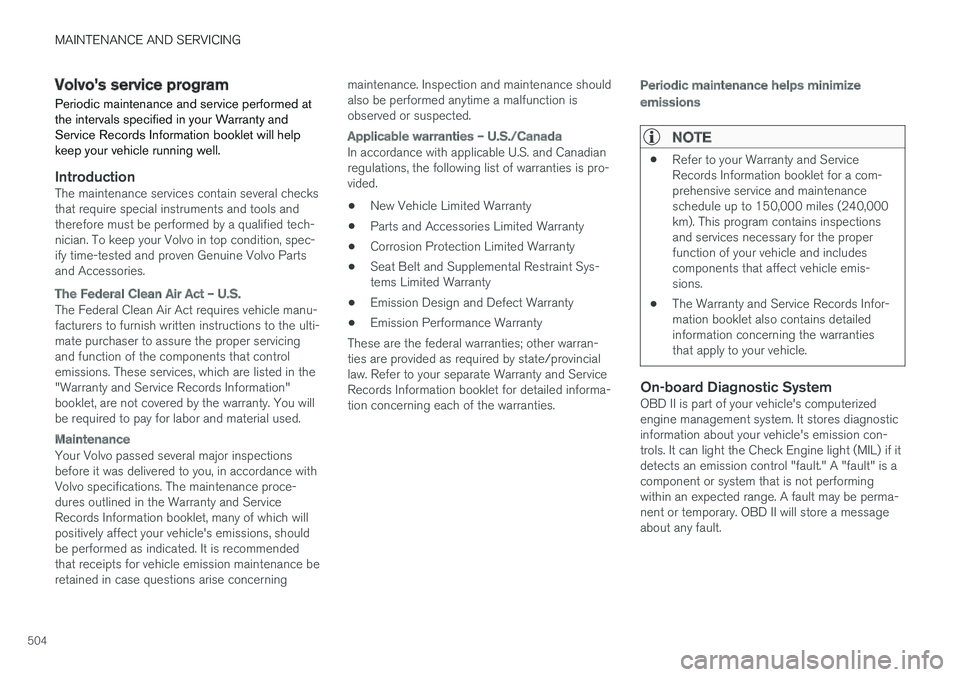
MAINTENANCE AND SERVICING
504
Volvo's service program
Periodic maintenance and service performed atthe intervals specified in your Warranty andService Records Information booklet will helpkeep your vehicle running well.
Introduction
The maintenance services contain several checksthat require special instruments and tools andtherefore must be performed by a qualified tech-nician. To keep your Volvo in top condition, spec-ify time-tested and proven Genuine Volvo Partsand Accessories.
The Federal Clean Air Act – U.S.
The Federal Clean Air Act requires vehicle manu-facturers to furnish written instructions to the ulti-mate purchaser to assure the proper servicingand function of the components that controlemissions. These services, which are listed in the"Warranty and Service Records Information"booklet, are not covered by the warranty. You willbe required to pay for labor and material used.
Maintenance
Your Volvo passed several major inspectionsbefore it was delivered to you, in accordance withVolvo specifications. The maintenance proce-dures outlined in the Warranty and ServiceRecords Information booklet, many of which willpositively affect your vehicle's emissions, shouldbe performed as indicated. It is recommendedthat receipts for vehicle emission maintenance beretained in case questions arise concerning
maintenance. Inspection and maintenance shouldalso be performed anytime a malfunction isobserved or suspected.
Applicable warranties – U.S./Canada
In accordance with applicable U.S. and Canadianregulations, the following list of warranties is pro-vided.
•New Vehicle Limited Warranty
•Parts and Accessories Limited Warranty
•Corrosion Protection Limited Warranty
•Seat Belt and Supplemental Restraint Sys-tems Limited Warranty
•Emission Design and Defect Warranty
•Emission Performance Warranty
These are the federal warranties; other warran-ties are provided as required by state/provinciallaw. Refer to your separate Warranty and ServiceRecords Information booklet for detailed informa-tion concerning each of the warranties.
Periodic maintenance helps minimize
emissions
NOTE
•Refer to your Warranty and ServiceRecords Information booklet for a com-prehensive service and maintenanceschedule up to 150,000 miles (240,000km). This program contains inspectionsand services necessary for the properfunction of your vehicle and includescomponents that affect vehicle emis-sions.
•The Warranty and Service Records Infor-mation booklet also contains detailedinformation concerning the warrantiesthat apply to your vehicle.
On-board Diagnostic System
OBD II is part of your vehicle's computerizedengine management system. It stores diagnosticinformation about your vehicle's emission con-trols. It can light the Check Engine light (MIL) if itdetects an emission control "fault." A "fault" is acomponent or system that is not performingwithin an expected range. A fault may be perma-nent or temporary. OBD II will store a messageabout any fault.
Page 507 of 584
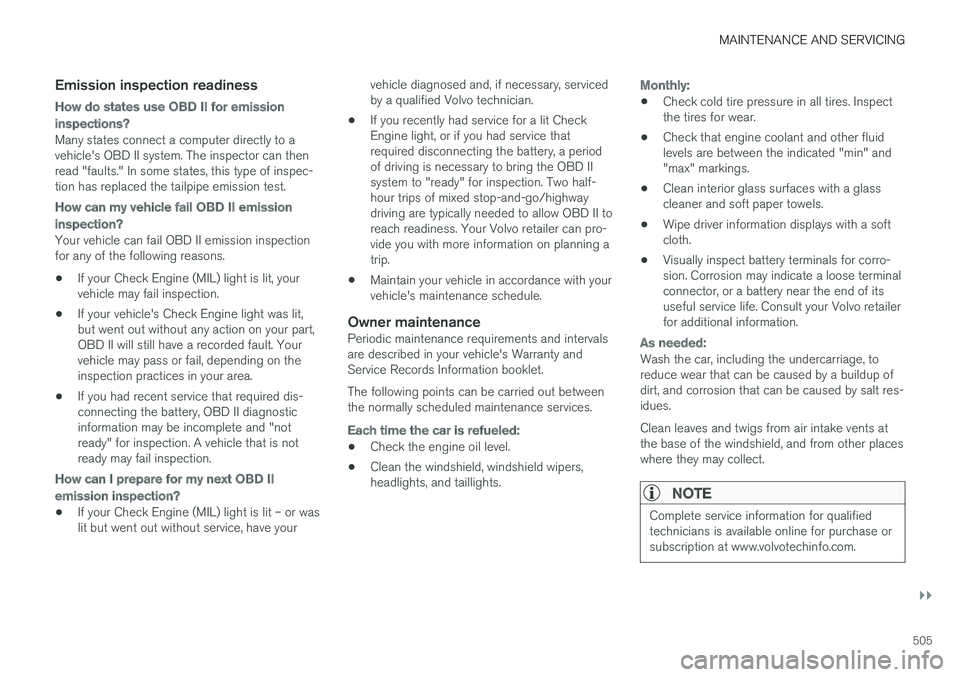
MAINTENANCE AND SERVICING
}}
505
Emission inspection readiness
How do states use OBD II for emission
inspections?
Many states connect a computer directly to avehicle's OBD II system. The inspector can thenread "faults." In some states, this type of inspec-tion has replaced the tailpipe emission test.
How can my vehicle fail OBD II emission
inspection?
Your vehicle can fail OBD II emission inspectionfor any of the following reasons.
•If your Check Engine (MIL) light is lit, yourvehicle may fail inspection.
•If your vehicle's Check Engine light was lit,but went out without any action on your part,OBD II will still have a recorded fault. Yourvehicle may pass or fail, depending on theinspection practices in your area.
•If you had recent service that required dis-connecting the battery, OBD II diagnosticinformation may be incomplete and "notready" for inspection. A vehicle that is notready may fail inspection.
How can I prepare for my next OBD II
emission inspection?
•If your Check Engine (MIL) light is lit – or waslit but went out without service, have your
vehicle diagnosed and, if necessary, servicedby a qualified Volvo technician.
•If you recently had service for a lit CheckEngine light, or if you had service thatrequired disconnecting the battery, a periodof driving is necessary to bring the OBD IIsystem to "ready" for inspection. Two half-hour trips of mixed stop-and-go/highwaydriving are typically needed to allow OBD II toreach readiness. Your Volvo retailer can pro-vide you with more information on planning atrip.
•Maintain your vehicle in accordance with yourvehicle's maintenance schedule.
Owner maintenance
Periodic maintenance requirements and intervalsare described in your vehicle's Warranty andService Records Information booklet.
The following points can be carried out betweenthe normally scheduled maintenance services.
Each time the car is refueled:
•Check the engine oil level.
•Clean the windshield, windshield wipers,headlights, and taillights.
Monthly:
•Check cold tire pressure in all tires. Inspectthe tires for wear.
•Check that engine coolant and other fluidlevels are between the indicated "min" and"max" markings.
•Clean interior glass surfaces with a glasscleaner and soft paper towels.
•Wipe driver information displays with a softcloth.
•Visually inspect battery terminals for corro-sion. Corrosion may indicate a loose terminalconnector, or a battery near the end of itsuseful service life. Consult your Volvo retailerfor additional information.
As needed:
Wash the car, including the undercarriage, toreduce wear that can be caused by a buildup ofdirt, and corrosion that can be caused by salt res-idues.
Clean leaves and twigs from air intake vents atthe base of the windshield, and from other placeswhere they may collect.
NOTE
Complete service information for qualifiedtechnicians is available online for purchase orsubscription at www.volvotechinfo.com.
Page 509 of 584
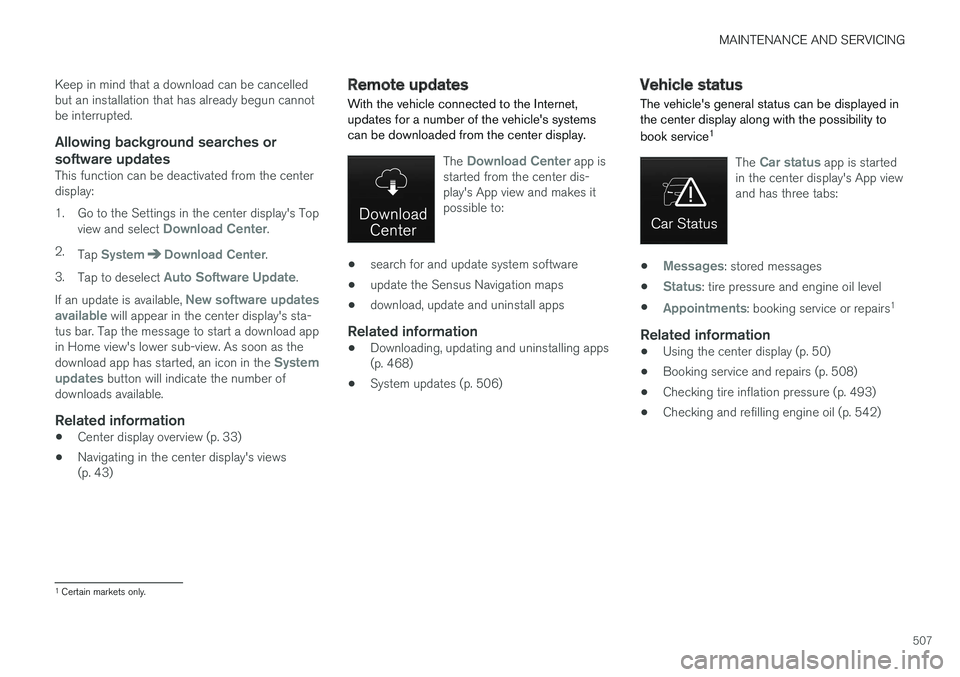
MAINTENANCE AND SERVICING
507
Keep in mind that a download can be cancelledbut an installation that has already begun cannotbe interrupted.
Allowing background searches or
software updates
This function can be deactivated from the centerdisplay:
1. Go to the Settings in the center display's Topview and select Download Center.
2.Tap SystemDownload Center.
3.Tap to deselect Auto Software Update.
If an update is available, New software updatesavailable will appear in the center display's sta-tus bar. Tap the message to start a download appin Home view's lower sub-view. As soon as thedownload app has started, an icon in the Systemupdates button will indicate the number ofdownloads available.
Related information
•Center display overview (p. 33)
•Navigating in the center display's views(p. 43)
Remote updates
With the vehicle connected to the Internet,updates for a number of the vehicle's systemscan be downloaded from the center display.
The Download Center app isstarted from the center dis-play's App view and makes itpossible to:
•search for and update system software
•update the Sensus Navigation maps
•download, update and uninstall apps
Related information
•Downloading, updating and uninstalling apps(p. 468)
•System updates (p. 506)
Vehicle status
The vehicle's general status can be displayed inthe center display along with the possibility to
book service1
The Car status app is startedin the center display's App viewand has three tabs:
•Messages: stored messages
•Status: tire pressure and engine oil level
•Appointments: booking service or repairs1
Related information
•Using the center display (p. 50)
•Booking service and repairs (p. 508)
•Checking tire inflation pressure (p. 493)
•Checking and refilling engine oil (p. 542)
1Certain markets only.
Page 542 of 584

||
MAINTENANCE AND SERVICING
540
Hood completely closed
Related information
•Engine compartment overview (p. 540)
•Door and seat belt reminders (p. 70)
Engine compartment overview
The engine compartment overview shows somemaintenance points.
Some of the components in the vehicle's electri-cal drive system are located in the engine com-partment.
WARNING
•Orange cables should only be handled bya trained and qualified Volvo service tech-nician.
•A number of the vehicle's componentsuse high voltage and can be very danger-ous if handled improperly.
•Do not touch any components that havenot been clearly described/explained inthis manual.
•Use caution when checking/refilling flu-ids in the engine compartment.
•The cooling fan (located at the front ofthe engine compartment, behind the radi-ator) may start or continue to operate (forup to 6 minutes) after the engine hasbeen switched off.
•Engine cleaning should only be done by aworkshop. If engine cleaning agents areused when the engine has been running,there may a fire risk.
•Before performing any operations in theengine compartment, the ignition shouldalways be completely switched off (inmode 0) and there should be no remotekeys in the passenger compartment. Thegear selector should be in the P (park)position. If the engine has been running,wait until it has cooled before touchingany components in the engine compart-ment.
•The distributor ignition system operatesat very high voltages. Special safety pre-